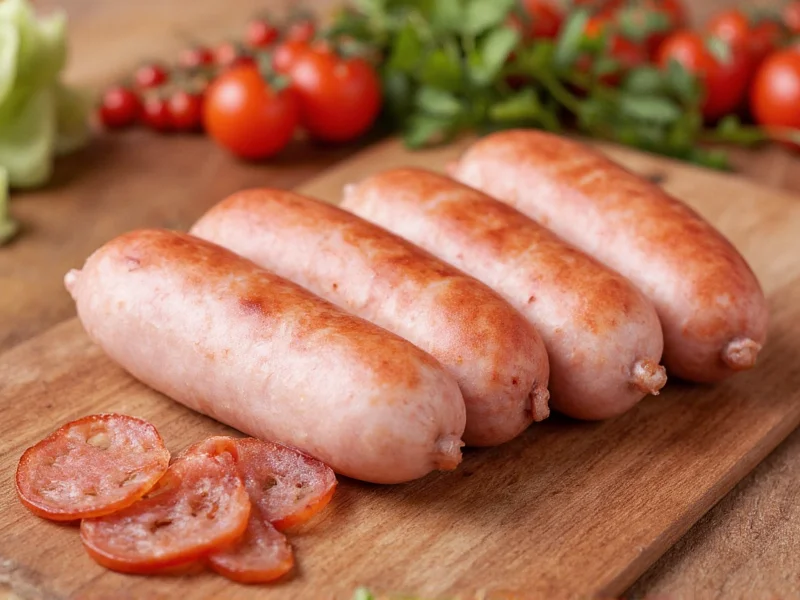Italian cuisine boasts an impressive variety of regional sausages, each with distinctive characteristics that reflect local traditions and ingredients. Among these, bianco sausage stands as a culinary treasure that embodies the subtlety and sophistication of Northern Italian cooking traditions. This white sausage variation offers a refined alternative to the more commonly known spicy Italian sausages that dominate menus worldwide.
Origins of Bianco Sausage in Italian Culinary Tradition
The term "bianco" translates to "white" in Italian, directly referencing the sausage's pale appearance. Unlike traditional Italian sausages that incorporate paprika or crushed red pepper for color and heat, bianco sausage deliberately omits these ingredients. This culinary choice originated in Northern Italy, particularly in regions like Lombardy and Piedmont, where chefs favored more delicate flavor profiles that wouldn't overpower accompanying dishes.
Historical records indicate that bianco sausage developed as a specialty for refined dining occasions. Wealthy families during the Renaissance period often requested milder sausages that complemented their sophisticated meals without overwhelming other flavors. The absence of red coloring agents also made bianco sausage visually distinct, creating an elegant presentation on platters alongside other cured meats.
Ingredients and Preparation Methods
Authentic bianco sausage follows a precise recipe that balances simplicity with complex flavors. The core ingredients include:
- Finely ground pork (typically 70% lean to 30% fat ratio)
- Fresh parsley, finely chopped
- Garlic, minced
- White wine (usually a dry Italian variety)
- Fennel seeds
- Black pepper
- Nutmeg
- Salt
- Natural pork casings
The preparation process requires careful attention to detail. Butchers grind the pork twice to achieve the perfect texture, then mix in the seasonings thoroughly. The white wine serves multiple purposes—it adds flavor, helps bind the mixture, and contributes to the sausage's distinctive pale color. Unlike red sausages that develop color from paprika, bianco sausage maintains its light hue throughout the curing process.
| Characteristic | Bianco Sausage | Traditional Italian Sausage |
|---|---|---|
| Color | Pale white/light beige | Reddish-orange |
| Primary Seasoning | White wine, parsley, fennel | Paprika, red pepper flakes |
| Heat Level | Mild (0-2,000 SHU) | Medium to hot (5,000-15,000 SHU) |
| Regional Origin | Northern Italy | Southern Italy |
| Traditional Pairings | Risotto, polenta, white beans | Peppers, onions, tomato-based sauces |
Culinary Applications and Pairing Recommendations
Chefs value bianco sausage for its versatility in creating balanced dishes where the sausage complements rather than dominates. When cooking with bianco sausage, consider these traditional applications:
Risotto enhancement: Crumbled bianco sausage adds richness to mushroom or vegetable risottos without introducing competing colors or overwhelming heat. The sausage's white wine component naturally complements the wine typically used in risotto preparation.
Polenta partner: Sliced and pan-fried bianco sausage serves as an elegant topping for creamy polenta. The mild flavor allows the corn flavor to shine while providing necessary protein.
Bean accompaniment: In Northern Italian tradition, bianco sausage often appears alongside cannellini beans in a dish called "fagioli con la salsiccia bianca." The sausage's delicate seasoning enhances rather than overpowers the subtle bean flavor.
Cooking bianco sausage requires attention to temperature. Unlike its red counterpart, which can withstand higher heat, bianco sausage benefits from gentle cooking to preserve its delicate flavor profile. Chefs recommend cooking at medium-low heat, turning frequently until the internal temperature reaches 160°F (71°C).
Finding Authentic Bianco Sausage
Locating genuine bianco sausage can present challenges outside of Italy. Specialty Italian markets often carry it, particularly those with strong Northern Italian connections. When shopping for bianco sausage, look for these quality indicators:
- No visible red coloring agents in the meat
- Fresh parsley flecks throughout the sausage
- Moist but not wet texture
- Distinct herbal aroma without overpowering spice notes
If unavailable, you can create a suitable substitute by removing paprika and red pepper from a standard Italian sausage recipe and increasing the white wine and parsley content. Some artisanal butchers offer custom preparation upon request, especially if you provide them with authentic recipes.
Maintaining Quality in Homemade Bianco Sausage
For home cooks interested in preparing bianco sausage, maintaining the proper fat ratio proves crucial. The 70-30 lean-to-fat ratio ensures adequate moisture during cooking while preventing greasiness. When mixing ingredients, keep everything chilled to maintain the proper texture—warm meat causes fat to smear rather than remain distinct.
The casing selection also impacts final quality. Natural pork casings work best for traditional bianco sausage, providing the right snap and texture. When filling casings, avoid overstuffing, which can cause bursting during cooking. Instead, fill to about 80% capacity to allow for expansion.











 浙公网安备
33010002000092号
浙公网安备
33010002000092号 浙B2-20120091-4
浙B2-20120091-4